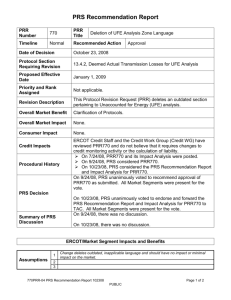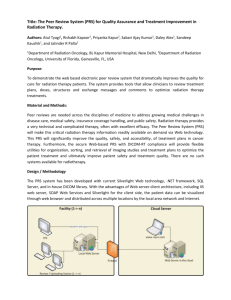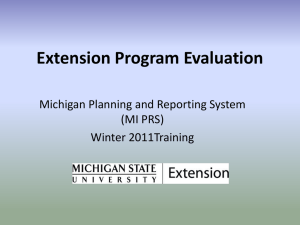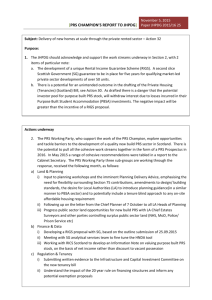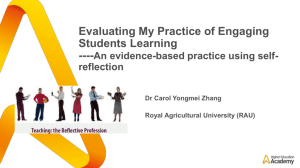Brochure - Pierre Robin Australia Inc
advertisement
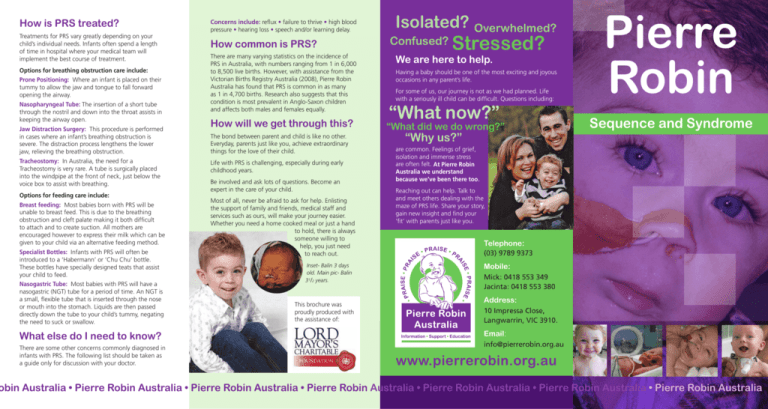
How is PRS treated? Treatments for PRS vary greatly depending on your child’s individual needs. Infants often spend a length of time in hospital where your medical team will implement the best course of treatment. Options for breathing obstruction care include: Prone Positioning: Where an infant is placed on their tummy to allow the jaw and tongue to fall forward opening the airway. Nasopharyngeal Tube: The insertion of a short tube through the nostril and down into the throat assists in keeping the airway open. Jaw Distraction Surgery: This procedure is performed in cases where an infant’s breathing obstruction is severe. The distraction process lengthens the lower jaw, relieving the breathing obstruction. Tracheostomy: In Australia, the need for a Tracheostomy is very rare. A tube is surgically placed into the windpipe at the front of neck, just below the voice box to assist with breathing. Options for feeding care include: Breast feeding: Most babies born with PRS will be unable to breast feed. This is due to the breathing obstruction and cleft palate making it both difficult to attach and to create suction. All mothers are encouraged however to express their milk which can be given to your child via an alternative feeding method. Specialist Bottles: Infants with PRS will often be introduced to a ‘Habermann’ or ‘Chu Chu’ bottle. These bottles have specially designed teats that assist your child to feed. Nasogastric Tube: Most babies with PRS will have a nasogastric (NGT) tube for a period of time. An NGT is a small, flexible tube that is inserted through the nose or mouth into the stomach. Liquids are then passed directly down the tube to your child’s tummy, negating the need to suck or swallow. What else do I need to know? There are some other concerns commonly diagnosed in infants with PRS. The following list should be taken as a guide only for discussion with your doctor. Concerns include: reflux • failure to thrive • high blood pressure • hearing loss • speech and/or learning delay. How common is PRS? There are many varying statistics on the incidence of PRS in Australia, with numbers ranging from 1 in 6,000 to 8,500 live births. However, with assistance from the Victorian Births Registry Australia (2008), Pierre Robin Australia has found that PRS is common in as many as 1 in 4,700 births. Research also suggests that this condition is most prevalent in Anglo-Saxon children and affects both males and females equally. How will we get through this? The bond between parent and child is like no other. Everyday, parents just like you, achieve extraordinary things for the love of their child. Life with PRS is challenging, especially during early childhood years. Be involved and ask lots of questions. Become an expert in the care of your child. Most of all, never be afraid to ask for help. Enlisting the support of family and friends, medical staff and services such as ours, will make your journey easier. Whether you need a home cooked meal or just a hand to hold, there is always someone willing to help, you just need to reach out. Inset- Balin 3 days old. Main pic- Balin 31/2 years. This brochure was proudly produced with the assistance of: Isolated? Overwhelmed? Confused? Stressed? We are here to help... Having a baby should be one of the most exciting and joyous occasions in any parent’s life. For some of us, our journey is not as we had planned. Life with a seriously ill child can be difficult. Questions including: “What now?” “What did we do wrong?” “Why us?” Pierre Robin Sequence and Syndrome are common. Feelings of grief, isolation and immense stress are often felt. At Pierre Robin Australia we understand because we’ve been there too. Reaching out can help. Talk to and meet others dealing with the maze of PRS life. Share your story, gain new insight and find your ‘fit’ with parents just like you. Telephone: (03) 9789 9373 Mobile: Mick: 0418 553 349 Jacinta: 0418 553 380 Address: 10 Impressa Close, Langwarrin, VIC 3910. Email: info@pierrerobin.org.au www.pierrerobin.org.au obin Australia • Pierre Robin Australia • Pierre Robin Australia • Pierre Robin Australia • Pierre Robin Australia • Pierre Robin Australia • Pierre Robin Australia What is PRS? Most people have never heard of PRS and have never been given the opportunity to learn more about it. Referred to by various names including: PRS Pierre Robin Sequence Pierre Robin Syndrome Robin Anomalad Pierre Robin Malformation Sequence Available information for the condition is varied and conflicting. The following aims to provide a basic overview of the most current and relevant facts available. Before we begin, there is one important point we must express: Children born with Pierre Robin are all unique. PRS can present in varying degrees, from a mild case requiring minimal intervention through to its most chronic form. Each and every PRS child is an individual, and needs be treated as such. Over time you will come to learn more about your child’s special attributes and any ongoing needs that may present. The most important thing you can do for your child every day is ‘be involved’. Your love and nurturing provides much needed stability. Pierre Robin (Pronounced ‘Ro-ban’) Sequence (PRS) is a condition characterised by the existence of three abnormalities: Why is Pierre Robin called a ‘Sequence’ not ‘Syndrome’? •A small, underdeveloped The term ‘Sequence’ has replaced ‘Syndrome’ in more recent times as medical professionals learn more about the condition and its origins. Through general observation, your doctor will determine a PRS diagnosis. In some cases the presence of a small jaw and cleft palate can be seen in-utero with medical imaging, however a diagnoses for PRS can only be truly made by examining your infant after birth. This is because the underdeveloped lower jaw begins a sequence of events, which leads to the abnormal placement of the tongue, resulting in the cleft palate and respiratory obstruction. Your doctor will review your baby to determine that the three elements of PRS are prevalent. Diagnosis can occur shortly following birth or it may take a few days for the airway obstruction to become apparent. The term ‘Syndrome’ is generally applied when there is a genetic cause for the condition. Is PRS a genetic disorder? lower jaw, (micrognathia) pronounced ‘micro-nath-ea’, or •A lower jaw that sits back further than the upper jaw (retrognathia) pronounced ‘retro-nath-ia’. • A cleft palate •Upper respiratory breathing obstruction The existence of all three abnormalities together determines the diagnosis of Pierre Robin Sequence. During the very early stages of pregnancy, a foetus’s jaw goes through a rapid growth period. In a child with PRS, this growth is stunted, resulting in the lower jaw being much smaller than its expected size. The palate is generally formed at around 8 - 10 weeks gestation, when the two shelves of the palate grow and join at the midline forming the ‘roof of the mouth’. In infants with PRS, the tongue is pushed up high into this cavity preventing the joining of the plates, resulting in a cleft of the soft and/or hard palate. After an infant is born, breathing obstruction results from the position of the tongue within the mouth. Due to the small jaw, the tongue is pushed backwards into the airway, resulting in difficulty breathing. This is known as ‘Upper Airway Breathing Obstruction’. What causes PRS? How is PRS diagnosed? Currently, there is no genetic test to diagnose PRS. •Genetic abnormalities. When PRS It should be noted however that approximately 65% of children diagnosed with PRS are reported to have coexistent syndromes including Sticklers and Velocardialfacial Syndromes. If present, these conditions do have a genetic origin, with blood tests able to assist in the diagnosis of these co-existing conditions. •Over crowding in the uterus. PRS is You will be referred to a team of genetic specialists to help determine your infant’s individual diagnosis. The exact cause for PRS is unknown. There are many theories as to why PRS occurs. Some of the most common theories suggest that PRS is caused by occurs with another condition. more common in multiple births. •Foetal positioning. That PRS is caused by the positioning of the head of the foetus in early pregnancy. •‘Switch Gene Theory’. More recent studies suggest that if PRS is not diagnosed in conjunction with another condition, the ‘Switch Gene Theory’ is the most appropriate cause for the sequence. ‘Switch Gene Theory’ suggests that the gene which initiates the normal growth and development of the bones of the jaw does not activate during the early stages of foetal development. As a result, the normal growth of the jaw is delayed Will my child need surgery? All babies with PRS will need to have surgery to repair their cleft palate. This is performed at between 9 and 18 months of age depending on your child’s circumstances. This is a reasonably short procedure usually only requiring a 2 night hospital stay. Also common are the insertion of ‘grommets’ into the eardrums. These are small tubes designed to relieve pressure and reduce fluid blockages in the ears. Other surgeries specific to your child’s medical needs may be required and will be discussed with you by your doctor should the need arise. obin Australia • Pierre Robin Australia • Pierre Robin Australia • Pierre Robin Australia • Pierre Robin Australia • Pierre Robin Australia • Pierre Robin Australia
